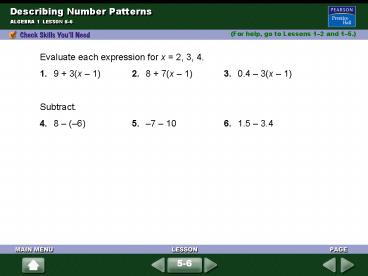Describing Number Patterns PowerPoint PPT Presentation
1 / 6
Title: Describing Number Patterns
1
Describing Number Patterns
ALGEBRA 1 LESSON 5-6
(For help, go to Lessons 12 and 15.)
Evaluate each expression for x 2, 3, 4. 1. 9
3(x 1) 2. 8 7(x 1) 3. 0.4 3(x
1) Subtract. 4. 8 (6) 5. 7 10 6. 1.5 3.4
5-6
2
Describing Number Patterns
ALGEBRA 1 LESSON 5-6
1. 9 3(x 1)for x 2 9 3(2 1) 9
3(1) 9 3 12for x 3 9 3(3 1) 9
3(2) 9 6 15for x 4 9 3(4 1) 9
3(3) 9 9 18 2. 8 7(x 1)for x 2 8
7(2 1) 8 7(1) 8 7 15for x 3 8
7(3 1) 8 7(2) 8 14 22for x 4 8
7(4 1) 8 7(3) 8 21 29 3. 0.4 3(x
1)for x 2 0.4 - 3(2 1) 0.4 3(1) 0.4
3 2.6for x 3 0.4 - 3(3 1) 0.4 3(2)
0.4 6 5.6for x 4 0.4 - 3(4 1) 0.4
3(3) 0.4 9 8.6 4. 8 (6) 8 6
14 5. 7 10 7 (10) 17 6. 1.5 3.4
1.5 (3.4) 1.9
Solutions
5-6
3
Describing Number Patterns
ALGEBRA 1 LESSON 5-6
Use inductive reasoning to describe the pattern.
Then find the next two numbers in the pattern.
a. 1, 5, 9
To find the next two numbers, you add 4 to each
previous term 9 4 13 and 13 4 17.
b. 1, 3, 9
To find the next two numbers, you multiply each
previous term by 3 9 ? 3 27 and 27 ? 3 81.
c. 1, 9, 25, 49, . . .
The pattern is square of consecutive odd
integers.
To find the next two numbers, square the next
two consecutive integers 92 81, 112 121.
5-6
4
Describing Number Patterns
ALGEBRA 1 LESSON 5-6
Find the common difference of each arithmetic
sequence.
a. 5, 2, 1, 4
b. 8, 11, 14, 17
5-6
5
Describing Number Patterns
ALGEBRA 1 LESSON 5-6
Find the first, fifth, and tenth terms of the
sequence that has the rule A(n) 15 (n 1)(5).
first term A(1) 15 (1 1)(5) 15 0(5)
15
fifth term A(5) 15 (5 1)(5) 15 4(5)
35
tenth term A(10) 15 (10 1)(5) 15 9(5)
60
5-6
6
Describing Number Patterns
ALGEBRA 1 LESSON 5-6
1. Use inductive reasoning to describe each
pattern. Then find the next two numbers in each
pattern. a. 1, 2.5, 4, ... b. , , ,
...
1 2
1 4
1 8
add 1.5 to the previous term 5.5, 7
2. Find the common difference of each arithmetic
sequence. a. 1, , , 0, ... b. 46,
34, 22, 10, ...
2 3
1 3
1 3
12
3. Find the second, sixth, and ninth terms of the
sequence that has the rule A(n) 3 (n 1)(6).
3, 27, 45
4. Is 2, 3, 8, 10, ... an arithmetic sequence?
Explain.
No the difference between the first two terms is
5, but the difference between the fourth and
third terms is 2.
5-6

